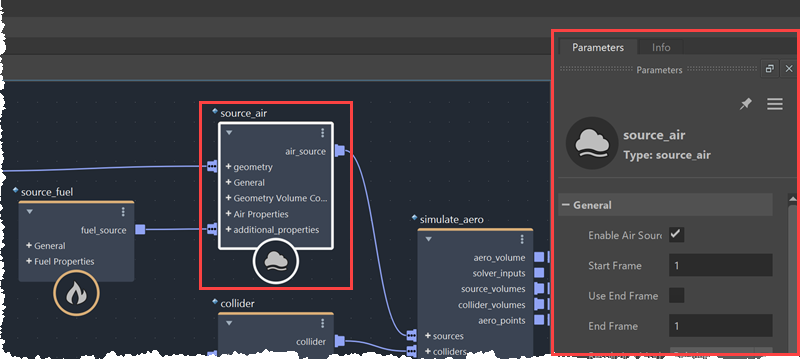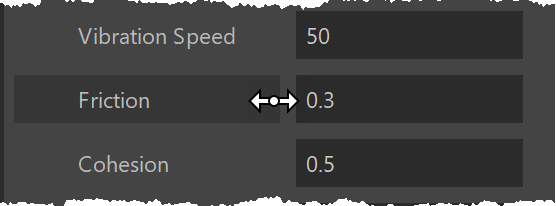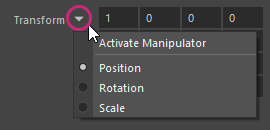Set input values on ports
Use the Parameter Editor to set input values on the unconnected ports of the selected node. If the Parameter Editor is not displayed, choose Edit > Parameter Editor.

The first time that you change the value of an unconnected input in a graph, the whole graph must be recompiled before it can be executed again with the new value. This can take some time but when it happens, the graph is recompiled using dynamic constants at that level. This means that subsequent value changes at the same level do not require recompilation, which makes updates much faster.
For numeric values, move the pointer over the field or label until it changes to a slider, and then:
- Click and drag to use the virtual slider.
- Click in the numeric box to place the cursor and type a value.

When using the slider, click and drag to the right to increase values or to the left to decrease values. The slider wraps at the edge of the screen, so you can drag continuously.
The slider’s rate of change is exponential: dragging it to the right about 150 pixels doubles the current value, and dragging it twice as far quadruples it. You can adjust the speed with modifier keys:
- Shift+drag for 10× speed.
- Ctrl+drag for 1/10 speed.
- Ctrl+Shift+drag for 1/100 speed.
When the value is between -1 and 1, the rate of change is linear instead of exponential. This makes it easier to fine-tune the value, and prevents it from becoming trapped at 0.
For a vector or matrix, using the slider on the label scales all components by the same amount. The exception is when all components are 0, in which case it adds the same amount to each component. To modify a single component, use the slider on an individual numeric box.
To set multiple values at once:
- Click in a numeric box or a parameter label to highlight it.
- Shift+click to highlight additional boxes or labels.
- Use slider over any of the highlighted boxes or labels to adjust them all together.
Port manipulators in Maya
You can use manipulators in the Maya viewport to set the value of 3D and 4D vectors and matrices (both single and double-precision floating point). To activate manipulators, right-click on a port icon or label in the graph and then select Activate Manipulator or a specific option from the Manipulator Defaults menu. Make sure to choose the manipulator that corresponds to how the value is used in the graph, such as Position or Scale. Note that Euler angles always use the XYZ order.

You can also activate the manipulator by clicking the triangle next to the value in the Parameter Editor.

Once the manipulator is active for matrices and similar types like Rigging::Module::Pin, you can switch between modes using the standard Maya hotkeys: W to translate, E to rotate, and R to scale.
Bifrost parameters in Maya
The unconnected parameters of other top-level graph nodes can be edited in the Bifrost > Parameters group using the Bifrost Parameter Editor's interface. Use the Bifrost Node drop-down to select the node to edit first, and then edit its parameters directly within Maya's Attribute Editor. Note that you cannot animate these parameters using the tools in Maya.

Arrays
You can add and edit items in an array directly in the Parameter Editor when there's no input connected.
- Use the plus (1) button to add a new element.
- Use the trash (2) button to remove an existing element.

Global variables
Global variables are connections to the host scene that are automatically created and managed by Bifrost. For example, if you add a time node and use it to compute a graph output, Bifrost automatically creates a connection to the scene's time.
You can see these global variables in the Parameter Editor when you deselect all nodes at the top level of a graph. They are also visible in the host application as extra input attributes on the graph's node.
Normally, you do not need to interact with these global variables since they are mostly handled by Bifrost. However, there are exceptions such as when using Flow Wedging.